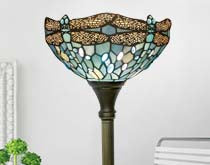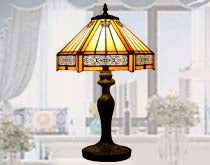Why do the LED lights keep flickering: Solutions
LED lights are loved by many for their efficiency, energy savings, and long life. The smart lighting of LED bulbs and Tiffany lamps shades are perfect partners to bring high-quality lighting and a warm feeling to your space.
However, sometimes, we may encounter the problem of flickering LED lights, which not only affects the lighting effect but also may cause damage to our eyes. So, why do LED lights flicker?
Related reading: How to Put a Tiffany Lamp Together

1. Downlight and Dimmer Compatibility
You may have noticed that when you install a new LED downlight, it starts to flicker. This could be due to a technical difference between your downlight and dimmer, causing them to be incompatible.
To avoid this, it is recommended that you check the product manual before purchasing your LED downlight to ensure compatibility between them. Alternatively, you can opt for a dimmer designed specifically for LEDs, which will ensure optimal performance and compatibility.
2. Chain reaction
Sometimes, you may find that the lights in an entire room are flickering, even if only one bulb is faulty. This is because a problem with one bulb may affect the entire circuit.
It is recommended that you check each bulb regularly to ensure that they are all working properly. Once you find a faulty bulb, replace it promptly so that you can avoid affecting the entire system.
3. Loose connections
Over time, due to daily vibration or usage, the connection of the bulb or fixture may loosen, resulting in unstable current flow, which causes flickering.
Every now and then, it is recommended that you check and ensure that all connections are tight to avoid flickering caused by loose connections.

4. Dusty or dirty sockets
Dust and dirt on the socket may obstruct the steady flow of current and cause the bulb to flicker.
To ensure that the socket is clean and dry, it is recommended that you disconnect the power and clean the socket regularly after the bulb has cooled down completely, using a clean cloth or special cleaner.
5. Loose electrical cords
Cords can indeed become loose or damaged with prolonged use, frequent vibration, or excessive bending. When cords are bent excessively, their outer protective coating may peel off or break, which not only leads to unstable current flow but also increases the risk of electric shock.
Therefore, to ensure the safety and stability of electrical cords, avoid frequently adjusting their routes or bending them excessively, and check the condition of the cords regularly.
If you find any damaged or exposed parts of the cords, you should replace or repair them promptly.
It is recommended that you regularly check the cord connections to make sure they are all tight and consider using longer-lasting, durable cords.
6. Installation of non-dimmable bulbs
Not all LED bulbs support the dimming function. If you use a bulb on a dimmer that does not support dimming, it may cause flickering.
When purchasing a bulb, make sure it supports dimming. If you have purchased a bulb that does not support dimming, it is recommended that you replace it or not use it on a dimmer.
7. LED Driver Issues
The LED driver is the heart of the LED lamp, it ensures that the LED lamp gets the proper voltage and current. Unlike traditional incandescent or fluorescent lamps, LED lights require a constant current to operate properly, not a constant voltage.
Therefore, the role of the driver is to convert the alternating current (AC) from the household power supply to the direct current (DC) and ensure that the current is stabilized.
Even high-quality smart LED lights may flicker if an unsuitable driver is used. This is akin to using an inappropriate cell phone charger, which may result in slow charging or no charging at all.
Like any electronic device, an LED driver has a lifespan. Over time, it can break down for a variety of reasons, such as voltage fluctuations, temperature changes, or simple wear and tear. When the driver is damaged, it may not be able to provide a steady current to the LED lights, causing them to flicker.
Solution:
- Check compatibility: When purchasing LED lights or drivers, make sure they are compatible. Many manufacturers provide a list of recommended drivers.
- Replace the driver: If it is determined that the driver is the source of the problem, replacing the driver with a new one that is compatible with the LED light is usually the easiest solution.
- Regular maintenance: In order to ensure the long life and stability of your LED lights, it is necessary to check the driver and other related components on a regular basis.
8. Overload circuits
If the load on a circuit exceeds its capacity, it may cause the current to become unstable and thus cause flickering.
For example, if several computers are in use, the air conditioner is in use, the microwave oven is also in use, and the kettle is working at this time, then it is likely to lead directly to a power failure and tripping situation.
It is recommended that you avoid using several high-power devices at the same time and ensure that the load on the circuit does not exceed its capacity.
9. Aging or damaged LED lights
As the usage time grows, the LED lights may age or get damaged, resulting in a decrease in their performance.
To ensure the durability of the LED lights, it is recommended that you regularly check the status of the LED lights and replace them once they are found to be aged or damaged.
Tiffany fixtures with LED
The advantages of LED bulbs are:
- LED bulbs consume far less power than traditional incandescent and fluorescent bulbs, which means that they can consume significantly less electricity while providing the same level of brightness.
- LED bulbs typically last between 15,000 and 50,000 hours, far longer than traditional bulbs. This means that users do not need to replace bulbs as often, reducing maintenance costs.
The design of Tiffany fixtures, especially their colored glass, provides a perfect stage for LEDs. Since LED bulbs distribute light evenly, they better highlight the stained glass design of Tiffany fixtures, making them more vivid and three-dimensional.
Plus LED bulbs are available in a variety of color temperatures, from warm yellow to cool white. Users can choose the right color temperature based on the color of the Tiffany fixture and the style of their home décor.

To ensure that the LED bulbs in Tiffany fixtures do not flicker, users should pay attention to the following points:
- Choose high-quality LED bulbs: Not all LED bulbs are created equal. Choosing well-known brands and certified LED bulbs can greatly reduce the risk of flickering.
- Ensure stable circuitry: Unstable power supply or voltage fluctuations may cause LED bulbs to flicker. Make sure the circuitry in your home is stable and consider using a voltage regulator.
- Use the right driver: As mentioned earlier, using a driver that is compatible with your LED bulbs is key to preventing flickering.
In conclusion
Hopefully, discovering the reasons why LED keep flickering in this article will help you solve some of your troubles so that you can continue to enjoy a stable lighting experience.

























